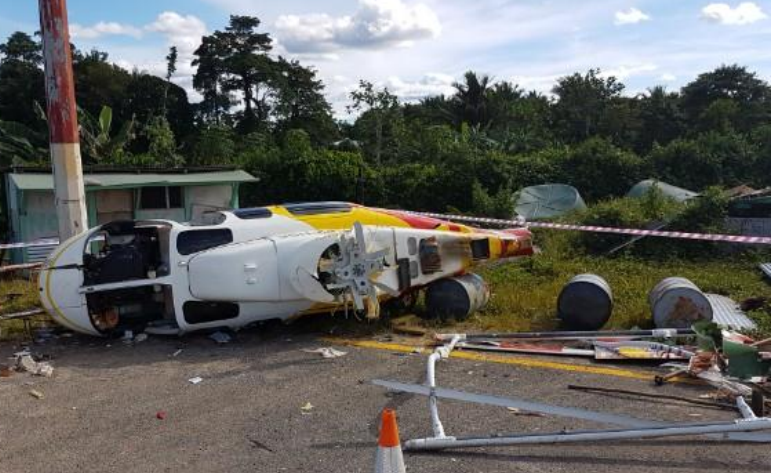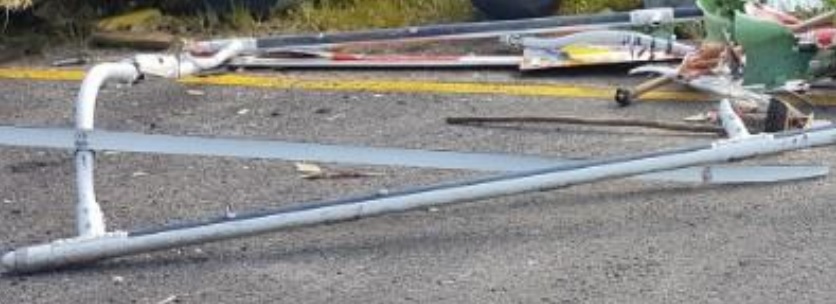Unexpected Load: AS350B3 Under Slung Load (USL) / HESLO Accident in Norway
The Accident Investigation Board Norway (AIBN – the Statens Havarikommisjon for Transport [SHT] in Norwegian) has issued its final report on a helicopter accident that occurred in Troms, Norway on 20 July 2016. It involved Airbus Helicopters AS350B3 LN-OSN of HeliScan that was supporting powerline construction by Consorzio Italia 2000 for power utility Statnett with Helicopter External Sling Load Operations (HESLO). The AIBN report that:
During a landing to load off [three] personnel, an external load was attached to the helicopter by longline without the commander being aware of it.
At lift off, the long line tightened, and the commander experienced a jerk in the helicopter that made him decide to make an emergency landing in terrain with birch trees. The rotor blades and the landing gear sustained damage.
The pilot, the sole occupant, was uninjured.
It emerged during the investigation that it was given an unclear message from the [construction company] principal who gave room for the commander and task specialist to have different understanding of the task to be performed.
The commander had the notion that it should be transport of [all] personnel from a mast point along the power line [as he had just move three of the five personnel from that site].
[The] task specialist, who believed that stringing of pilot lines was the next task [and that only the key personnel needed to be moved], attached longline to the load hook.
The Stringing of a Pilot Line During Powerline Construction: Note the use of a 10-15m Longline (Credit: HeliScan)
This caused the helicopter to take off in such a way that [4 seconds into the flight] there was a strong pull due to the weight that hung in longline when it was tightened.
The report [only available in Norwegian] focuses on cooperation and communication between the commander and task specialist, and the equipment used for communication.
The AIBN note that:
EASA OPS Annex VIII Part-SPO (Special Operations) Subpart E HESLO (Helicopter Sling Load Operations) which was introduced in Norway 1 January 2016 has in its AMC / GM (Acceptable Means of Compliance / Guidance Material) defined minimum standards for communication equipment to be used in this type of assignment:
AMC 1 SPO.SPEC.HESLO.100 Standard operating procedures, Party C Equipment (4) Adequate radio communication equipment (eg VHF, UHF, VHF) should be installed and serviceable in the helicopter for co-ordination with the task specialists Involved in the operation. (5) Task specialists Involved in the operation should be equipped with hand-held communication equipment, protective helmets with integrated earphones and microphones.
In this case the task specialist / loadmaster did not use his more basic hand-held VHF radio because of the noise. The helicopter was fitted with mirrors that would have given the pilot a view of the belly hook but as the pilot was not expecting a load to be added, the action of the task specialist went unnoticed.
In 2009 the Norwegian Civil Aviation Authority (the NCAA or Luftfartstilsynet) established an air safety forum for operators of inland helicopters, which commissioned a safety study:
The reason for this study was a concern for the development of aviation safety in this part of the Norwegian helicopter operations. In particular the accident rate for aerial work and passenger flights [is] unsettling.
The study was released in December 2013 and included 41 recommendations. Two of these were linked to this accident by the AIBN:
- Recommendation T04 Training between pilot and load master. “This measure will help strengthen crew members total skill level with regard to counteract operational errors”.
- Recommendation T22 Personal equipment for pilots and loadmasters. “The measure is expected to increase crew members safety. In addition, measure contribute to signal opposite crew members that safety is a priority in company”.
The AIBN note that that study also showed a perception that passenger flights were much lower risk than other aerial work tasks and postulate that perception may have contributed to a lower level of attention when expecting a passenger flight compared to the aerial work tasks that were subject to the completion of a specific Job Analysis and Risk Assessment Form.
The AIBN note the communication failure between load master and commander when a change in plan occurred.
Responsibility for a common understanding of what should be carried out on a mission rests with the helicopter company working personnel. One must inform each other’s intentions and changes, and confirm that the information is received.
No safety recommendations are made by the AIBN in connection with this investigation.
Also see our articles:
- What the HEC?! – Human External Cargo
- Helicopter Underslung Load: TV Transmitter
- French Skyscraper: Helicopter Underslung Load
- Keep Your Eyes on the Hook! Underslung External Load Safety
- EC120 Underslung Load Accident 26 September 2013 – Report
- The Tender Trap – the design of aviation service tenders and contracts
- UPDATE 5 February 2017: Our new article Fatal Low Altitude Hover Power Loss: Power Line Maintenance Project looks at how an engine compressor failure while installing power line markers resulted in an unsurvivable impact and fire.
- UPDATE 3 June 2018: Helicopter Wildlife Netting Accidents
- UPDATE 28 July 2018: Wayward Window: Fatal Loss of a Fire-Fighting Helicopter in NZ
- UPDATE 1 December 2018: Helicopter Tail Rotor Strike from Firefighting Bucket
The Flight Safety Foundation (FSF) run Helicopter External Load Operations for Ground Personnel training.
UPDATE 10 November 2017: Just 11 days after we wrote this article a Bell 407 in Papua New Guinea, P2-HSE of Niugini Helicopters suffered a very similar fate according to an investigation report published by the PNG AIC.
On 15 February 2017, at approximately 05:00 UTC (15:00 local), the pilot…was commencing a normal
translational-lift takeoff, to the south-south west, across the aerodrome apron, and over the terminal buildings. The flight was a VFR charter operation carrying two passengers to a Digicel [mobile phone] tower site, 20 nm south of Kiunga Aerodrome.The pilot reported that when the helicopter was about 100 ft AGL and at a speed (IAS) about 30 or 40 kts, it suddenly jerked to the left, rapidly descended, and impacted the tarmac, and was destroyed. The pilot and both passengers sustained minor injuries.
A 50 m longline attached to a net carrying three full 200 L metal drums containing diesel fuel, was ‘attached’ to the helicopter.
The Operator did not have any qualified person tasked to carry out the duties of a loadmaster for any of the sling operations out of Kiunga.
During the interview with the AIC, the pilot stated that he brought out the longline and authorised the [non-operator] personnel to load the drums into the net. He said he gave them instructions on how to load them, stating that they should put the drums upright.
He said that he was unaware that the longline that he and the passengers had prepared for the next flight to the same location, was attached to the helicopter prior to lift-off.
One of the passengers was the service/maintenance technician for R&A Marine Services. The pilot reported that this passenger did not usually assist with the ground work. The other passenger, a Kiunga local, was the technician’s assistant, and his job was to carry tools and equipment for the technician. He assisted the pilot by loading the drums in the net and rigging it. He had little education and was barely literate in English.
When he was…interviewed, he stated that he had not hooked the line to the helicopter, and that it was not on the hook at all. He stated that he had thrown the line under the helicopter and notified the pilot that the line was running over the skid to which he said the pilot replied, “thanks for reminding me”
The helicopter was fitted with a retractable mirror, but the pilot did not use it during the pre-start and takeoff. The pilot stated that it was a passenger ‘only’ flight, and so he did not need to deploy the mirror.
There is no evidence to suggest that the long line was hooked onto the belly hook of the helicopter. The investigation determined that the sling was not attached to the belly hook of the helicopter. It draped over the left step, above the left landing gear skid of the helicopter.
It is likely that in throwing the line under the helicopter, the shackle draped over the step and skid from under the helicopter.
During the take off and forward flight, the sling played out to its full length and became taut when the shackle snagged on the step, abruptly arresting the forward movement of the helicopter, and dragging it down onto its left side in uncontrolled flight. The step subsequently fractured as a result of the applied load. As the helicopter was dragged down, recovery from the uncontrolled flight was not possible from such a low height.
Safety Resources
- UPDATE 21 October 2018: Fallacy of ‘Training Out’ Error: Japanese AS332L1 Dropped Load
- UPDATE 13 July 2019: Helicopter Wirestrike During Powerline Inspection
- UPDATE 18 July 2019: UK AAIB report on a fatal accident to AS350B2 G-PLMH during HESLO with a boat at Loch Scadavay, Western Isles, Scotland, 13 June 2018.
- UPDATE 16 September 2019: Fatal Snowy Powerline Inspection Flight
- UPDATE 20 December 2019: Helicopter External Sling Load Operation Occurrences in New Zealand
- UPDATE 28 June 2020: Maintenance Issues in Fire-Fighting S-61A Accident
- UPDATE 7 September 2020: Shocking Accident: Two Workers Electrocuted During HESLO
- UPDATE 31 October 2020: Loss of Control During HESLO Construction Task: BEA Highlight Wellbeing / Personal Readiness
- UPDATE 2 April 2021: Windscreen Rain Refraction: Mountain Mine Site HESLO CFIT
- UPDATE 24 April 2021: Unballasted Sling Stings Speedy Squirrel (HESLO in France)
- UPDATE 12 June 2021: HESLO Dynamic Rollover in Alaska
- UPDATE 28 August 2021: Ditching after Blade Strike During HESLO from a Ship
- UPDATE 4 September 2021: Dynamic Rollover During HESLO at Gusty Mountain Site
- UPDATE 25 September 2021: Fuel Starvation During Powerline HESLO
- UPDATE 1 January 2022: Snagged Sling Line Pulled into Main Rotor During HESLO Shutdown
- UPDATE 3 September 2022: Garbage Pilot Becomes Electric Hooker
- UPDATE 18 March 2023: HESLO AS350 Fatal Accident Positioning with an Unloaded Long Line
Aerossurance is pleased to sponsor the 2017 European Society of Air Safety Investigators (ESASI) 8th Regional Seminar in Ljubljana, Slovenia on 19 and 20 April 2017. Registration is just €100 per delegate. To register for the seminar please follow this link. ESASI is the European chapter of the International Society of Air Safety Investigators (ISASI).






Recent Comments